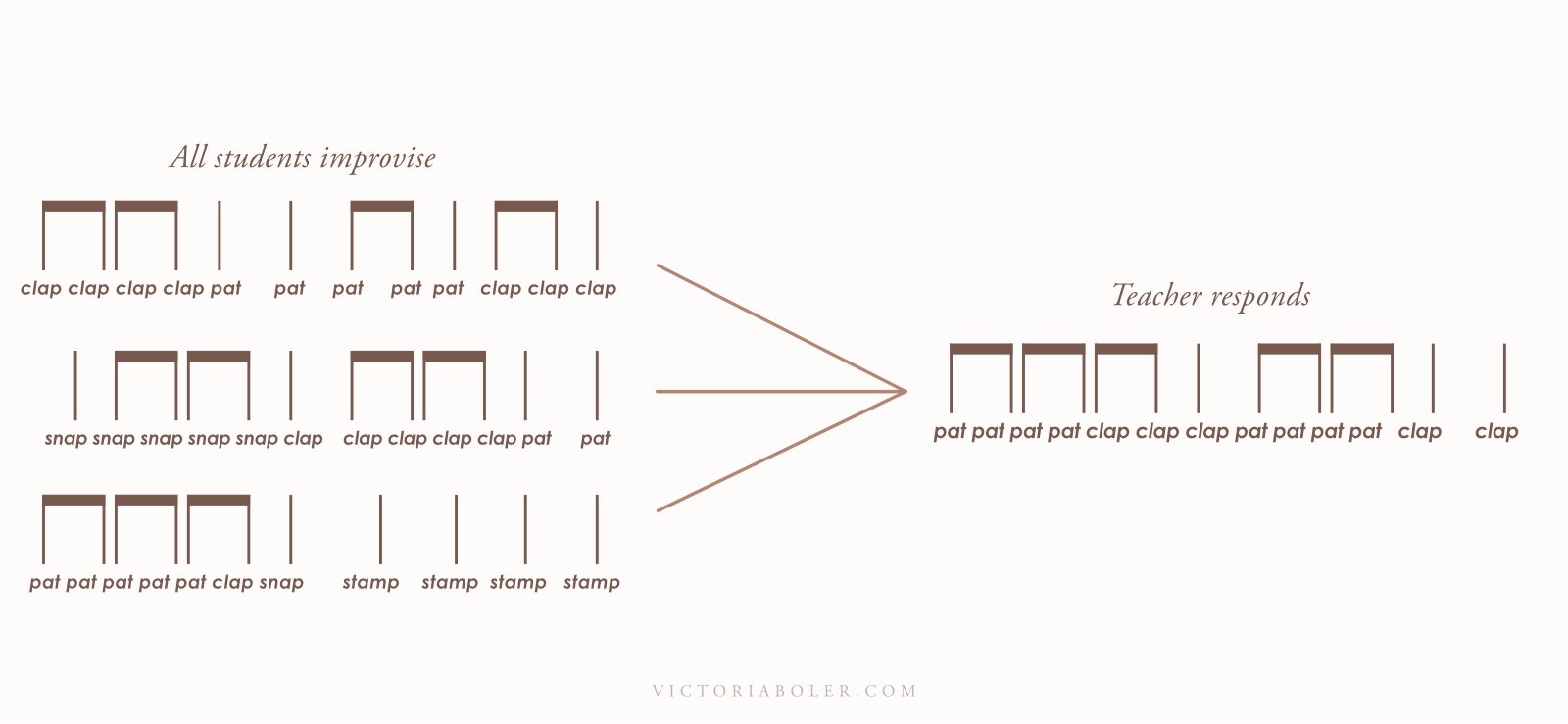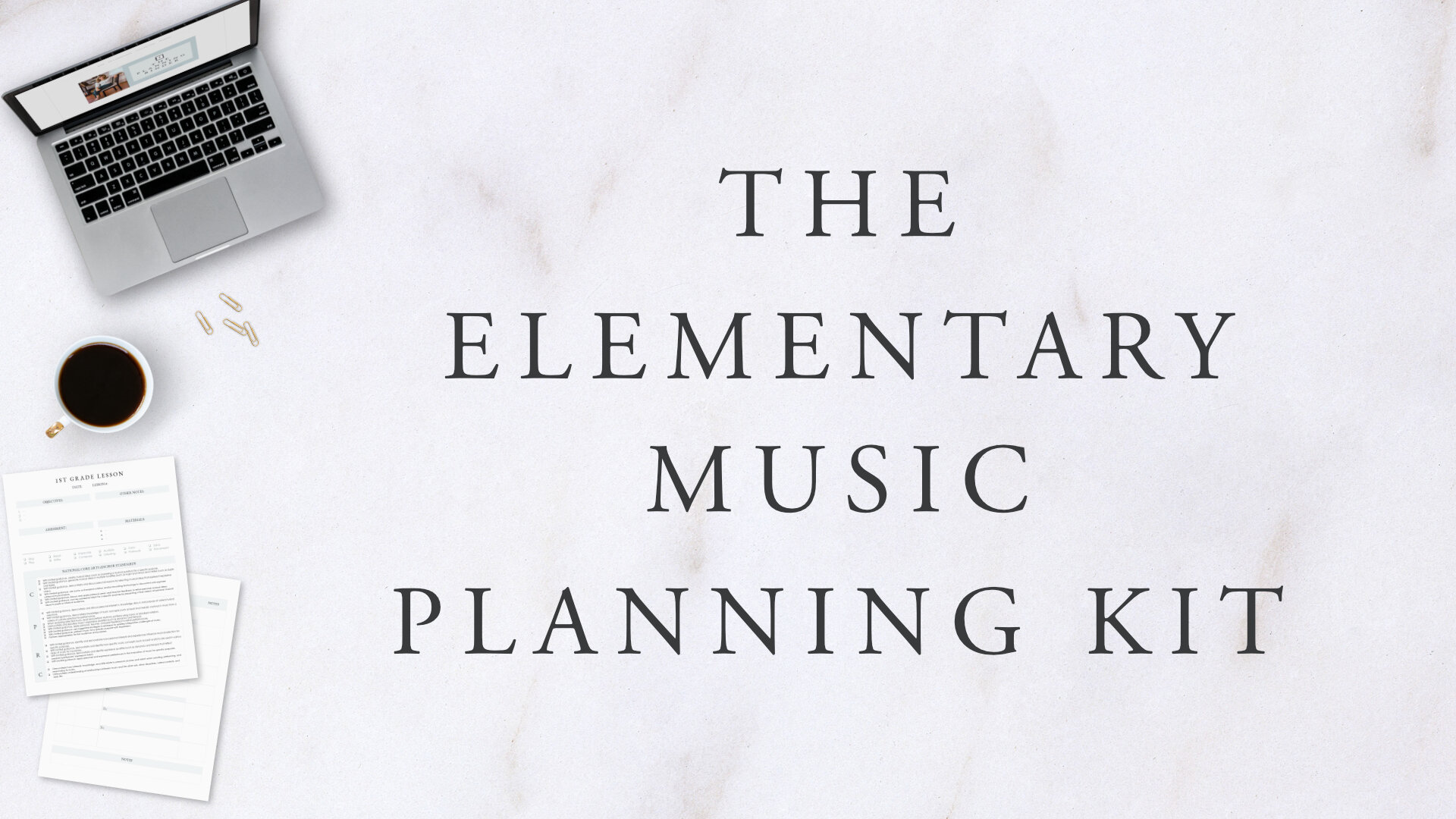One of the main barriers to including creative processes in elementary general music is that there never seems to be enough time!
Despite the fact that most music teachers say they value the creative arts, the reality of teaching music is that there is limited time in a lesson, and limited lessons in a year. We spend our time in active music rooms joyfully singing, playing, speaking, moving, reading, writing. It can sometimes feel as though creative processes are one more thing to cram into an already-full lesson block.
In this podcast episode, Anne Mileski and I talked about the value of using the warm up routine to set the tone for music class. If we feel that community and creativity are priorities for us, a beautiful way to incorporate them is in the warm up routine itself.
Let’s look at some structures for including improvisation in the warm up routine for elementary general music. We’ll focus on two songs from this post and imagine some ways to improvise with a rhythmic focus.
Let’s jump in.
The Songs
For these activities, we’ll focus on possibilities with two pieces of repertoire for lower grades: “Engine Engine Number Nine” and “One Two Three.” You can find more about them in this post.
In upper grades we’ll use the song, “Sunday Best” by Surfaces.
Rhythm Improvisation in the Warm Up Routine
Rhythm improvisation is a great starting point for students who are new to improvisation! If this is new territory for your campus, consider starting the process of with rhythm improvisation while continuing to echo vocal patterns.
Here are a few ideas to get started.
Engine Engine Number Nine
Potential Grades: Kinder - 2nd
This rhyme is well-loved in many music rooms for its versatility! For all these activities, students walk into the room speaking the rhyme in a line.
Imitation:
When all students are inside the music room, the teacher makes train sound rhythms and students echo.
Examples:
Exploration:
In a later class, students might have the option of echoing train sounds or creating their own train sounds that are different.
T: I think I hear another train coming by! My train said “chhh ch-ch ch-ch chhh” and I heard the other train say something different: “ch-ch ch-ch chhh chhh.”
Students choose if they’ll continue to stay on the teacher’s train and make the same train sounds, or if they’ll move to a different train and improvise their own train rhythms. During this portion of the improvisation sequence, listen for the length of students’ improvisations. They should match the length of the given four-beat pattern. This awareness of phrase length will tell us when it’s time to move on to the next step.
Example:
Improvisation:
After several experiences having the option to improvise or echo, all students are asked to improvise.
When students are ready, they improvise the first train and the teacher improvises a second train. In a later class, the teacher can divide the class in half.
Eventually, group train improvises the first set of train sounds and the second group improvises their train’s response.
One Two Three
Potential Grades: 2nd - 3rd
I wrote this song for The Planning Binder 2022 - 2023 school year. It’s another versatile selection that can be used for many musical ends!
Students walk in the room in a line, singing the song. Use the text of the song, “let’s clap our hands like this,” to move from imitation to improvisation over the course of several lessons.
Imitation:
Sing the song. As a B section, the teacher claps four-beat or eight-beat rhythms and students echo. Over time, the teacher adds in two levels of body percussion (such as clapping and patting), and perhaps up to four levels (snapping, clapping, patting, and stamping). Students echo with the teacher’s body percussion.
As students echo patterns with two levels of body percussion, pay attention to the fluency with which they switch timbres. Watching for the ease of switching levels will inform the pacing of the progression.
Exploration:
Sing the song as students enter. As a B section, the teacher plays four-beat or eight-beat rhythms on body percussion. Students repeat the rhythm, but play it on body percussion of their choice.
Example:
In later experiences, students can have the option of playing the same rhythm, or improvising a new response.
Improvisation:
When students are ready, we’ll ask them to improvise a new rhythm instead of echoing.
This opens up several new possibilities for creative interdependence:
Ask students to improvise the musical question (the first improvisation) and the teacher responds
Divide the class in half. One half improvises first. The second half of the class picks someone to watch, then improvises their own response.
Sing the song. During the main section (one two three, walk around and follow me), students step a steady beat to find a partner. At the end of the song students play their rhythm improvisations in question and answer form. Repeat the same activity as students walk to a new partner.
Sunday Best Rhythm Improvisation
Potential Grades: 3rd - 5th
Especially for older students who have not had previous classroom improvisation experience, it can be helpful to start the improvisation process with rhythm (through speech and / or body percussion) and then moving to vocal improvisation.
This process will be similar to the one for One Two Three.
Students enter the room playing a body percussion pattern as the song plays.
Imitation:
The teacher plays a few patterns on body percussion and students echo. Depending on the age, the place in the year, and the curricular sequence, consider incorporating target rhythms into the echo patterns.
Consider starting with two levels of body percussion and gradually increasing to four (snapping, clapping, patting, and stamping). Pay attention to the fluency with which students move from levels of body percussion. This gives important information about when to add levels of complexity with the body percussion patterns.
Examples with target element, syncop-pa:
Exploration
Students will likely be ready to move to exploration after a few experiences using imitation. In these exploration activities, the teacher plays a body percussion rhythm. Students echo the same rhythm on body percussion of their choice.
Students can also have the option of improvising their own rhythm response that is different than the teacher’s. During these experiences, listen for the length of student responses. If responses match the eight-beats of the teacher’s improvisation, that’s a great sign that students are ready to move on to improvisation.
Examples with target element, syncop-pa:
Improvisation:
When we hear that students are ready, we’ll ask everyone to improvise a new response that is different from ours.
From there, students improvise the rhythmic question and the teacher improvises a rhythmic answer.
This is another time to check that the length of students’ improvisations matches the phrase form set in previous classes.
As students become more comfortable with rhythm improvisation, we can expand the activity directions to increase the level of musical interdependence. Here are a few options:
Divide the class in half. One half improvises first. The second half of the class picks someone to watch, then improvises their own response.
Students turn to a shoulder partner. One musician improvises the first eight beats and the other musician improvises the response. Find a new partner and repeat.
Pairs of students combine to create a group of four. Each musician improvises eight beats, taking turns going around the circle. After that, groups of four combine to create a group of eight. Each musician improvises eight beats, taking turns going around the circle. Groups of eight combine with the whole class to continue the warm up routine.
Students improvise both the musical question and the musical answer on their own.
For groups who are ready for a challenge, invite them to try using part of their partner’s musical material in their response.
What’s Next?
I love incorporating improvisation into each class at the very beginning to set the tone of interdependent creativity.
The beauty if starting with rhythmic improvisation is that it is so accessible! If you’re looking for a way to ensure that improvisation is a part of every music class experience, consider trying some of these ideas.
In the next post we’ll explore some possible ways to build off of rhythmic improvisation into vocal creativity.

































